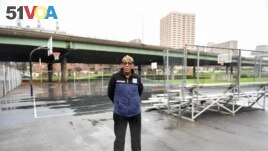31 May 2021
For more than 50 years, Interstate 81 highway has cut through the Southside neighborhood of Syracuse, a city in northwestern New York State. Smoke from vehicles traveling on the elevated road would fall down to the area where most people are Black and poor.
Now, New York State wants to replace that part of the elevated highway with a street-level road. The aim is to connect the city's urban areas again. And building could begin as soon as next year.

Community activist Charles Pierce-El poses for a portrait outside of Wilson Park near the I-81 freeway in Syracuse, New York, U.S., April 28, 2021.
The plan has raised hopes of better times in a city where one in three residents lives in poverty. Some say it could also make up for the damage done to Black residents during the building of Interstate 81 years ago. They were forced to move and have been living under the elevated highway ever since.
David Rufus is a lifelong Southside resident. He works as an organizer for the rights group New York Civil Liberties Union. He said, "When they put that highway up, they destroyed this community. Now here's an opportunity to right that wrong by bringing it down."
Syracuse was not the only U.S. city where highway-building in the 1950s and 1960s displaced Black residents.
Historians are now saying that local officials saw the proposed interstate highway system as an easy way to tear down what they regarded as "slum" neighborhoods near downtown business areas.
The U.S. federal government paid up to 90 percent of the cost of building the new highway. As residents had to move away, it was easier for politicians and business leaders to work on "urban renewal" projects.
Joseph DiMento is a law professor at the University of California, Irvine and an expert in the policies of the highway-building. "It was a mistake that many cities were making," he said. "The reasons they were built were heavily for removal of Blacks from certain areas," he added.
Road builders at the time were largely free to ignore environmental, historical, social or other concerns. That permitted them to pay attention only to the most direct way from one point to another.
Often, that meant directing those highways through Black neighborhoods, where land was inexpensive and there was little political opposition.
Raymond Mohl was an urban historian and professor at the University of Alabama at Birmingham. His research found that the highway builders targeted some Black neighborhoods even when better paths were available. His research found the following examples:
- In the city of Miami, Interstate 95 was built in Overtown, a Black neighborhood known as the "Harlem of the South," rather than a nearby unused train pathway.
- In Nashville, Tennessee, Interstate 40 took a sharp turn, cutting the Black community of North Nashville into two parts.
- In Montgomery, Alabama, the state highway director was a high-level officer of the Ku Klux Klan, a racist white group. He set the path for Interstate 85 through a neighborhood where many Black civil rights leaders lived.
- In New Orleans and Kansas City, officials moved highways from white neighborhoods to integrated or mostly Black areas.
Residents in a few cities, including Washington, D.C., Philadelphia and Baltimore, successfully organized to block highway building in Black neighborhoods. But that was not usually the case.
Anthony Foxx served as transportation secretary under President Barack Obama. He said that in all, highway building displaced more than 1 million Americans. Many of them were poor minorities.
I'm Jill Robbins.
Andy Sullivan wrote this story for Reuters. Jill Robbins adapted it for Learning English. Hai Do was the editor.
_
Words in This Story
highway – n. a wide road that is built for fast travel
elevated – adj. raised above the ground
resident – n. someone who lives in a particular place
displace – v. to force (people or animals) to leave the area where they live
slum - n. an area of a city where poor people live and the buildings are in bad condition
What do you think of the practice of placing roads through poor areas? Have you seen it where you live? We want to hear from you. Write to us in the Comments Section.












